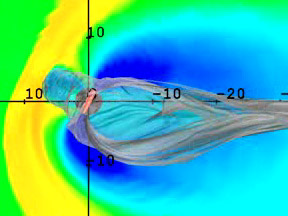This ultraviolet image of the Sun shows one of the largest solar flares ever seen. The flare, which erupted in November 2003, is the bright region along the Sun's right limb. The horizontal "spikes" extending to the right and left of the flare are not real; they are an artifact produced by the imaging instrument, which was overloaded by the intense brightness of this flare.
Click on image for full size
Image courtesy SOHO (NASA & ESA).
Solar Flares
Text for this level has not been written yet.
Please see the "Intermediate" text for this page if you want to learn about this topic.
To get to the "Intermediate" text, click on the blue "Intermediate" button at the top of the page (between the "Beginner" and "Advanced" buttons).
You might also be interested in:

Sunspots are dark spots on the Sun. They may look small, but they are actually as bigas a planet like Earth or Mars! Sunspots are "dark" because they are colder than the areas around them. Of course, they
...more
Interested in doing a project related to space weather for a science fair? The Stanford SOLAR Center provides information about space weather monitors that you can build yourself, including the Sudden
...more
Scientists who study space weather use models a lot. Just what is a model? It is a simplified way of looking at something very complicated. You may be familiar with a globe. It is a model of the Earth.
...more
An active region on the Sun is an area with an especially strong magnetic field. Sunspots frequently form in active regions. Active regions appear bright in X-ray and ultraviolet images. Solar activity,
...more
You probably have magnets on your refrigerator holding up some of your artwork or a photograph of a friend or family. Did you know that it is magnetic fields (which all magnets have) that make sunspots
...more
The sun goes through cycles that last approximately 11 years. These solar cycle include phases with more magnetic activity, sunspots, and solar flares. They also include phases with less activity. The
...more
The Sun is very important to the Earth. The Sun warms our planet, heating the surface, the oceans and the atmosphere. The Sun also gives us light. We definitely couldn't live on Earth without the Sun!
...more














